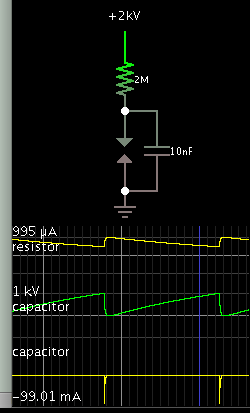Simulate electric discharge circuit
My name is Mike and I am electrical engineering student. I want to simulate an electric discharge circuit. I am using Simulink. I figured out that Mayr's model is the most accurate model for simulating electrical discharge (If you know something better please let me know). I found only a tiny bit of information about simulating electrical discharge. I am looking for a model that can give me good approximation about voltage spike due to this discharge. In general Mayr's model requires parameters that I don't really know how to get. I am really interested in modeling electrical discharge and its effects on the electrical grid.
Discharge circuit:Attached.
The discharge gap is around 0.4 mm.
C1,c2,c3- capacitors for required of charging and getting more Jowls.
Ra ? resistor required to charge the capacitors (Limiting the current).
R1,R2,R3 ? resistors for homogenous distribution of voltage
I really want to know what happens after the electrical discharge happens from voltage and current view point . I also want to build a spectral analysis to this electrical discharge.
I'm also interested in this topic , I hope to find someone to help us how to simulate the circuit
Falstad's simulator has a spark gap model. The menu contains 3 circuits for it.
www.falstad.com/circuit
To run the applet, your computer needs to have Java installed. The simulator is animated and interactive.
Spark gap:

Seems like a great simulator but I am intrested in the model too.
The model's behavior is governed by several parameters. You can examine these, and change them as you wish. Right-click on the component and select Edit.
It looks like a very simple ideal trigger device without specific relations to real gas discharge.
I am seeking for a better model then just a switch since I want to perform spectral analysis. thanx.
What's the frequency range of interest for your spectral analysis? The Cassie and Mayr arc model seems to attempt a behavioral simulation an arc discharge based on average thermodynamic parameters. I doubt that it represents the voltage and current waveforms in the sub microsecond range.
From one view point this electric discharge is required in my system and from other viewpoint point this discharge is tripping other electronics. I really want to see what frequencies are created due to this discharge and then build a filter. Are you familiar with Mayr simulink model ( I need to modify it so it will work as a discharge simulator)? As I said this is my approach (Student) if you are familiar with a better approach I will gladly take it :)
I'm not familiar with this and similar arc discharge models, I just take a look at it's structure and am quite sure that it can't give the answers you're looking for. A useful approach would be to either search for literature with waveforms of real world arc discharges, or probably better acquire some representative waveforms in a laboratory and use them for your filter design.
Look what I found :
http://ltwiki.org/index.php5?title=A...es_with_Analog
It works with LTspice. I have installed the program and simulated the circuit (spark_gap and spark_ignition) but I still can't understand where they got thier parameters from.
